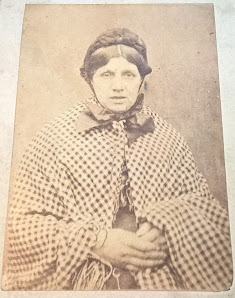England's First Female Serial Killer - Mary Ann Cotton
Mary Cotton is believed to be the first female serial killer in England and to this day it's not really known how many people she killed. I've been fascinated by her story ever since the TV series 'Dark Angel' was broadcast. I have also got a keen interest in crime and punishment, which this definitely peaks.
Birth
Mary Ann Robson was born on Halloween in 1832, in Low Moorsley, County Durham. Her birthday could have been seen as a sign of what was to come or to what would become of her, we will never know. Her parents Margaret and Michael would have her baptised eleven days later. She had a younger sister that only lived for a few months and a younger brother. When she was about eight her family moved to Murton, not long after the move her father fell down a 150 ft mine shaft and died in 1842. His body was delivered to her mother in a sack. Because of Michael's death it meant that the family would have to be evicted from their house. About a year later her mother remarried George Stott, who was also a miner. When she turned sixteen, Mary left home to become a nurse in the nearby village of South Hetton, in the household of Edward Potter, while there she helped to look after Edward's 5 children. After 3 years once the children had grown and were sent to boarding school, Mary Ann moved back home to her mother and step-fathers house. While there she decided to train as a dressmaker.
William Mowbury - First Husband
When she was twenty years old she married William Mowbray at a register's office in Newcastle Upon Tyne, not long after they moved to the South West of England. While they were away from County Durham about four or five of their children were said to have died, yet none of them were registered. Only one birth was recorded, that of their daughter Margaret Jane born in 1856. The couple soon moved back to the North East of England. William got a job as a fireman on a steam vessel that was sailing out of Sunderland. Another daughter, Isabella was born in 1858, then two years later Margaret Jane died. Within a year another daughter, Margaret Jane was born and then a son John, two years later. John died from gastric fever the following year.
William Mowbury passed away from an intestinal disorder in January of 1865. His life and that of the children were insured by the British and Prudential Insurance office. Upon the death of her husband, Mary would receive a payout of £35 (about £3,560 today) and upon the death of their son John a payout of £2 5s.
George Ward - Second Husband
Not long after William's death, Mary Ann moved to Seaham Harbour. It was here that she started a friendship with John Nattrass. It was also during this time that her daughter Margaret Jane, who was about three and half, died from typhus fever. This left Mary Ann with only one of the nine children that she had given birth to. Mary Ann moved back to Sunderland and would then get a job at the Sunderland Infirmary, House of Recovery for the Cure of Contagious Fever, Dispensary and Humane Society. While she was there she left her only remaining child Isabella with her mother and step-father.
While working at the infirmary she would meet her second husband George, the pair would marry in Monkwearmouth in August 1865. George would continue to suffer from ill health and would die in October 1866. It was thought that he died from a long illness characterised by paralysis and intestinal problems. On his death certificate, it was recorded at English cholera and typhoid. The doctor that was attending to George stated that he was very ill and that his death had been so sudden. Like with her previous husband, Mary Ann collected the payout from the insurance.
James Robinson - Third Husband
Mary Ann was in need of a job and managed to get a job as a housekeeper for James Robinson in November 1866. He was a shipwright whose wife had recently passed away. A month or so later James' youngest son John died from gastric fever, at the same time Mary Ann fell pregnant. Around the same time, her mother Margaret became ill with hepatitis, Mary Ann went to see her mother straight away. She started to recover but soon complained of stomach pains. Margaret passed away in the spring of 1867, roughly nine days after Mary Ann had arrived. Mary Ann took her daughter Isabella and went back to the Robinson household to pick up her job again.Once back in the household, Isabella and two of the Robinson children, Elizabeth and James started to suffer with severe stomach pains and died. All three were buried at the end of April in 1867. Mary Ann also received an insurance payout for Isabella of £5 10s 6s. About four months later Mary Ann and James were married in Bishopwearmouth. Their first child, Margaret Isabella, was born three months later, but she became ill and died a few months later. Their second child, George, was born in June 1869. While they were married Mary Ann tried to insure James, this caused him to become suspicious of her. He also discovered that she was running up a debt of over £60 and that she had stolen £50 from his bank. Mary Ann had also been sending James' older children to the pawn shop with household valuables. James decided to throw her out, but he kept the custody of their son George.
Frederick Cotton - Forth Husband
Cause she had been kicked out by James Robinson, Mary Ann was desperate, she was living on the streets and needed help. Her friend Margaret Cotton took her in and introduced her to her brother Frederick, she was looking after him and his two children, Frederick Jr and Charles, after he recently became a widow. Margaret died in March 1870 from an undetermined stomach ailment, this left Mary Ann to look after Frederick and begin her twelfth pregnancy. By the end of the year Mary Ann and Frederick were married in Newcastle-Upon-Tyne with their son Robert born at the start of the following year. When Mary Ann and Frederick married, she claimed that she was still Mowbray and not Robinson.
Mary Ann had heard that her old lover Joseph Nattrass was about 30 miles away in West Auckland, the pair soon rekindled their relationship and made her family move to be closer. Frederick passed away in December 1871 from gastric fever, life insurance had been placed on both Frederick Cotton and the lives of his sons.
Her two lovers
Once Frederick had died she decided to take Joseph Natrass in as her lodger. She also managed to gain employment as a nurse for either John or Richard Quick-Manning who was recovering from smallpox. There is no evidence of anyone called John but there was one with the name Richard, but little is known. While she was caring for this man she fell pregnant with her thirteenth child. Frederick's son Frederick Jr died in March 1872 with their son Robert not long after. Joseph also became ill with gastric fever and died after he had edited his will in favour of Mary Ann.Mary Ann's Downfall
A local parish official, Thomas Riley, asked her to help nurse a woman who was ill with smallpox, Mary Ann complained that Charles Cotton was in the way and asked if he could be sent to a workhouse. Mary Ann would have needed to have gone with the child, but she told Thomas that the boy won't be around much longer. Five days later Charles had passed away, when Thomas found out he went straight to the village police and told the doctor to investigate the death before writing the death certificate. Mary Ann tried to gain the life insurance for Charles, but was told she could't get it till the death certificate had been issued. An inquest was held in the local pub in-which the verdict came back as death of natural causes. She claimed that she had tried to relieve the boys symptoms and that Thomas Riley was making accusations against her after she had refused his advances. The local paper got hold of the story and soon latched on to Mary Ann after they discovered she had moved around a lot, lost three husbands, her lover, her mother and eleven children all to stomach fevers.
Arrest, Trial and Execution
The doctor that had attended to Charles Cotton had samples that were used to test for arsenic. He told the police what he had found and suggested that the body of Charles was exhumed. Mary Ann was charged with the murder of Charles, even through the trial was delayed till she had given birth to her final child, Margaret Edith Quick-Manning Cotton, in January 1873. Mary Ann's trial started in March, it was delayed due to the selection of the prosecution counsel. Charles Russell was appointed as the Attorney General and this would be the first of several poisoning cases that he would sit on.The defence team argued that Charles had died from inhaling arsenic that had been used as a dye in the wallpaper in the Cotton home. It was also suggested that the chemist had gotten the powders mixed up and given Mary Ann arsenic instead of bismuth powder to help treat the diarrhoea. The jury then retired for 90 minutes before then returned with a guilty verdict. All during her trial Mary Ann asserted her innocence of this crime, so much so there were several petitions that were then presented to the Home Secretary. But none of these helped her case. It was known that Mary Ann used arsenic to poison her victims, but it is thought that she used a little tea-pot to administer this poison.
Mary Ann Cotton was hung at Durham County Gaol on the 24th March 1873. William Calcraft over saw the execution and stated that she died not from her neck breaking, but by strangulation from the rope being rigged up to short. Her body was laid to rest within the grounds of the Gaol, but in 1990 her remains were exhumed during renovation work to the current jail. Her remains were taken away and cremated, the current location of her remains is now unknown. Out of her thirteen children, only two survived her, Margaret Edith and George Robinson. When look at her prison record, her age seems to be wrong, it has her down at 34 when she should have been in her 40's. There is no real evidence or reason as to why her age was different or changed.
To this day it is not know the exact number of people that Mary Ann murdered, it could be anywhere around twenty one, three of which where her husbands and a further twelve of her own children.Personal Items
Upon doing my research I found out that some of her personal items and letters are still around to this day. Like most serial killers the story of Mary Ann was all over the papers up and down the country. I find that the best papers from this time are The Police Illustrated News, many of these are online and can be seen as they followed her story as well as her trial and the verdict.
Bemish also has a small worn out three-legged wooden stool. It was donated in the 1970's by a local lady. The story behind the stool is that it belonged to and was used by Mary Ann while she was imprisoned at Durham Gaol. They were also sent a number of photocopies of some letters that Mary Ann wrote while she was in Durham Gaol awaiting her trial. These letters had been purchased from Ebay from a North Yorkshire auction house in 2013. The letters are hard to decipher, but can make out the mention of solicitors and financial issues.
I could go on and on with this blog and delve more into the rabbit hole that is Mary Ann Cotton's life. I feel that this is the best place to stop for now, but this is only the tip of the iceberg. I have a feeling there is more to her life then we know and I have a long way to go and more to find out. I would love to know where her remains were taken once they were cremated.











Comments
Post a Comment